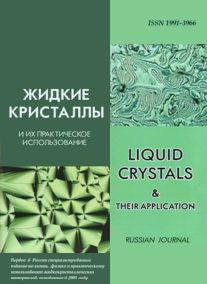|

|
Liquid Crystals and their Application
Russian Journal Zhidkie kristally i ikh prakticheskoe ispol'zovanie Жидкие кристаллы и их практическое использование |

|
|

|

|
|
|
Menu

|
|
|
|
|
Zhidk. krist. ikh prakt. ispol'z. = Liq. Cryst. and their Appl., 2016, 16 (1), 42—51.
DOI: 10.18083/LCAppl.2016.1.42 |

|
|
Effect of Composition and Regulators of the Molecular Weight and Structural Characteristics of (meth)acrylic Copolymer on the Electro-Optical Properties of the PDLC Films
|
A. N. Anisimov1, D. S. Shkirmantova1, S. A. Bulgakova1, S. A. Ryabov1, M. M. Jones2
|
Author affiliations
1Lobachevsky State University of Nizhny Novgorod – National Research University,
23 Prospekt Gagarina (Gagarin Avenue), Bld. 5, Nizhny Novgorod, 603950, Russia
2Reper ltd.,
1 Barrikad St., Nizhny Novgorod, 603003, Russia
E-mail: anisimovantonnnov@mail.ru
|
|
Abstract
The polymer-dispersed liquid crystal (PDLC) films have been prepared by method of acrylic monomers photopolymerization with dissolved liquid crystal. PDLC systems based on ethylhexyl acrylate (EHA) –methacrylic acid (MAA) and EHA – acrylic acid (AA) copolymers have been investigated. The optimal concentrations of acids in the polymer matrix in which there are minimum driving voltages have been identified. The optimum film thickness (35–40 microns) at which PDLC had the best electro-optical properties was determined on example of the EHA–MAA copolymer. Influence the polymer matrix modifiers such as dodecyl mercaptan (DDM) and ethylene glycol dimethacrylate (EGDM), both separately and together, on the morphology of the droplets and electro-optical system properties has been investigated. Micrographs of the modified films morphology were obtained. It was found that the maximum efficiency of the electro-optical properties is achieved when modifiers of the polymer matrix are used in conjunction in the ratio [DDM]/[EGDM] = 1. It is shown that in the modified structures a reduction of the threshold fields from 5,2 to 2,6 V/μm is achieved.
Keywords: polymer-liquid crystal composite, photopolymerization, electro-optical properties, dodecyl mercaptan, ethylene glycol dimethacrylate, 2-ethylhexyl acrylate, methacrylic acid, acrylic acid
|
|
|
|
|
|




